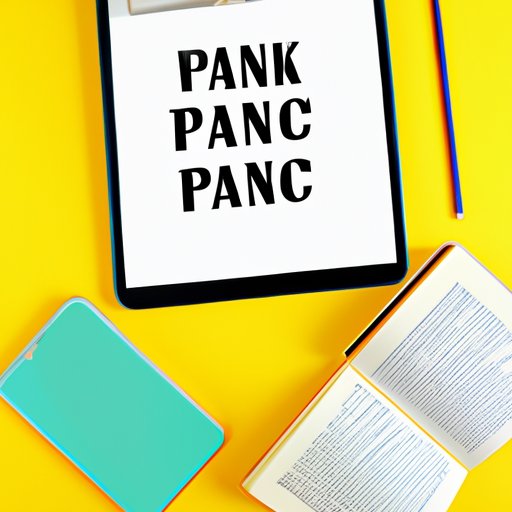I. Introduction
Panic attacks are a common mental health issue that affect millions of people worldwide. Symptoms of panic attacks can include rapid heart rate, sweating, trembling, and difficulty breathing. They can be extremely debilitating, leaving individuals feeling helpless and out of control.
The purpose of this article is to provide readers with effective techniques to manage and overcome panic attacks quickly. By practicing these techniques, readers can gain a sense of control over their symptoms and alleviate the distress of panic attacks.
II. Breathing Techniques
One of the most effective techniques for managing panic attacks is through breathing techniques. Deep breathing exercises help to regulate the body’s physiological responses and calm the mind.
One of the most popular breathing techniques is square breathing, which involves inhaling for four counts, holding the breath for four counts, exhaling for four counts, and holding for four counts.
Another technique is called 4-7-8 breathing, in which you inhale for four counts, hold your breath for seven counts, and exhale for eight counts. Repeat this cycle four times or until you start feeling calmer.
Breathing techniques help to activate the parasympathetic nervous system, which promotes relaxation and reduces the symptoms of panic attacks.
III. Distraction Methods
Distraction is an effective technique for managing panic attacks because it shifts the focus of your thoughts away from the anxiety/fear that can trigger a panic attack. Finding a distraction that works for you may take some trial and error, but once you find something that works, you’ll feel a sense of relief.
Simple activities like counting backwards from 100 or repeating a mantra can help distract the mind from the symptoms of a panic attack. Focusing on your senses by touching an object or looking at a picture can also help bring you back to the present moment.
The key is to find something that works for you and can be done easily when a panic attack arises.
IV. Mindfulness Exercises
Mindfulness exercises help to reduce stress and anxiety by increasing self-awareness. During a panic attack, your mind may be racing with negative thoughts. Practicing mindfulness can help you become aware of these thoughts and stop them from spiraling out of control.
Mindfulness exercises can range from simple breathing exercises to more structured practices like mindful meditation. Focusing on your breath or being present in the moment can help you manage the physical and emotional symptoms of a panic attack.
Practicing mindfulness exercises on a daily basis can also help improve overall mental health and well-being.
V. Positive Self-Talk Techniques
Positive self-talk involves replacing negative thoughts with positive and encouraging ones. During a panic attack, negative thoughts can escalate symptoms and make it difficult to calm down.
One way to reframe your thoughts is to use positive affirmations. Examples of positive affirmations include “I am safe” or “I can handle this.” Using positive affirmations can help interrupt the cycle of negative thoughts that contribute to panic attacks.
It’s important to cultivate a positive mindset as a long-term strategy for preventing future panic attacks.
VI. Relaxation Techniques
Relaxation techniques like progressive muscle relaxation and visualization can help to reduce anxiety and stress levels. Progressive muscle relaxation involves tensing and then relaxing each muscle group, starting with the toes and working upwards to the head.
Visualization involves mentally picturing a calming scene or activity, such as walking on the beach or listening to soft music. By focusing on the pleasant image, your body will begin to relax and calm down.
Practicing these techniques regularly can help keep anxiety and stress levels at bay, reducing the risk of future panic attacks.
VII. The Role of Medication
Medication can be an effective long-term solution for managing anxiety and panic attacks. Different types of medication, such as antidepressants and benzodiazepines, can provide relief from symptoms.
It’s important to speak to a doctor before starting any medication, and to carefully monitor any side effects or changes in symptoms. It’s crucial to only take medication under the guidance of a healthcare professional.
VIII. Lifestyle Changes
Finally, making lifestyle changes can help manage anxiety and prevent future panic attacks. Changes to diet and exercise, reducing stress in your life, spending time outdoors in nature, and improving your sleep habits can all have a positive impact on your mental health.
Small, manageable changes can lead to significant improvements in your overall well-being and ability to manage stress. Incorporating daily exercise and self-care routines can also help to keep stress at bay.
IX. Conclusion
By incorporating these techniques into your daily routine, you can manage and overcome panic attacks quickly and effectively. It’s important to remember that everyone’s experience with panic attacks is different, so it may take some trial and error to find the techniques that work best for you.
Remember to practice these techniques regularly and prioritize self-care for general mental well-being. If you continue to struggle with panic attacks despite trying these methods, reach out to a mental health professional for support.
